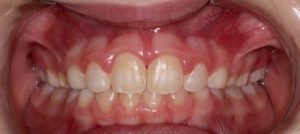Such a common question these days is why are so many young kids already in braces? We asked Board Certified Orthodontist Dr Fernanda Marchi from Fairfield County Orthodontics for a better understanding.
As a mom and an orthodontist, I get asked this question daily, both at my office and in my daily life. There is no one size fits all answer, however, the American Association of Orthodontists recommends that your child visit an orthodontist for a check-up by the age of seven so we can screen for potential issues that can be addressed prior to growth being completed. Performing an orthodontic evaluation while their teeth and jaws are still growing makes it easier to address certain orthodontic conditions. So, while not all children need Phase I or Interceptive Early treatment, many children benefit from it.
Some of the most common conditions that might require Phase I/Interceptive orthodontics:
- Crossbite: often the upper and lower jaws do not grow at the same rate, causing a discrepancy in size. The most common condition is a narrow (small) upper jaw that creates what we call a crossbite that can be unilateral or bilateral and usually requires expansion with a palatal expander to be corrected. It is beneficial to address this early on since it is a skeletal discrepancy and much easier to correct when the child is still young.
- Crowding: sometimes we have too many teeth and not enough space. Or the teeth are too wide for the size of the developing jaws. We can start addressing these issues early on for a better result.
- Early Baby Tooth Loss: A baby tooth can be viewed as a place holder for the permanent teeth. In the event a baby tooth is removed or falls out too early, the space may be lost, and the eruption of the permanent teeth compromised.
- Thumb or finger sucking habits: we work with your child to help them break these habits at the right time to avoid detrimental side effects.
- Impacted Permanent Teeth: during your initial consultation we will evaluate a radiograph (usually a panoramic radiograph) for the presence of impacted permanent teeth. The canines are the most commonly impacted permanent teeth that may require intervention during the early growth years.
- Missing or Extra Teeth: once we obtain the panoramic radiograph we can check for any missing or extra teeth and guide parents and children on the best options for treatment.
- Underbite: One of the most beneficial aspects of early treatment is the intervention for underbites. In this case, the lower jaw is growing at a faster pace than the upper and has a genetic predisposition to continue to grow, creating an underbite where the lower teeth are in front of the upper teeth. Due to the limited growth potential of the upper jaw, we recommend early treatment to address this as soon as possible.
- Open Bite: this is when the upper and lower front teeth do not touch at all- think of it as the patient cannot bite into a slice of pizza. We can evaluate children for different treatment modalities that could help decrease the severity of the open bite over time.
If there is a need for early treatment, or Phase I treatment as it is usually called, we work with the parents and the child to achieve the best result. Often there is a need for treatment but there are not enough teeth erupted or they need a little more time maturing so we place some children in an Observation phase. We usually see them every six months to evaluate for the best time to start treatment. We also coordinate Phase I treatment with Speech Language therapists and myofunctional therapists to achieve the best result. Your child’s general dentist will be a part of this also since we sometimes ask for primary teeth to be removed to help with the eruption of permanent teeth.
The most common treatment for young kids is the palatal expander. Most orthodontists use it to correct several skeletal and dental conditions and it has been proven to achieve excellent results. It may seem like a new idea, but the palatal expander has been used in orthodontics for more than a century. Sometimes, fixed braces are also used in early treatment, especially if we need to align crowded or misaligned teeth to help with eruption or impaction. The goal of early treatment or Phase I treatment is not to achieve full alignment and full bite correction. It is a proactive and conservative treatment that can help us provide more stable results in the future. Addressing the jaw growth and position of impacted teeth can help reduce potential damage to your child’s teeth, improve speech development, improve their airway, and reduce the need for future orthodontic procedures.
I hope this can help clear up some of the confusion and answer some questions about the most common Phase I conditions and potential treatment options. If there are any questions, we are always happy to help!
Fernanda Marchi, DDS
1275 Post Rd Suite 211
Fairfield, CT
203-292-6644
Fairfield County Orthodontic, LLC



